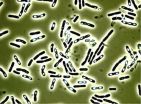(Press-News.org) Andres Pinto, an orofacial pain and oral medicine specialist at Case Western Reserve University School of Dental Medicine, often feels like the doctor in the television series House, who solves medical mysteries each week.
Pinto is among about 700 facial pain and oral medicine specialists nationally who patients often turn to when their own doctors are unable to identify and treat complex and rare medical conditions. In fact, according to a new study Pinto conducted with input from fellow members of the American Academy of Oral Medicine (AAOM), patients see, on average, 2.2 doctors over 17 months before visiting facial pain and oral medicine specialists, hoping to finally find the cause of their discomfort.
Unfortunately, Pinto said, the delay in getting treatment allows the pain to escalate from acute to the chronic stage, reducing the patient's quality of life dramatically.
Patients come from as far as the Gulf States to be evaluated and treated by the team of pain specialists at the CWRU dental school--one of just seven inclusive teams nationally and the only one in Ohio with specially trained head and neck radiologists, oral and maxillofacial medicine and orofacial pain clinicians and oral and maxillofacial pathologists all within one clinical setting.
Pinto, DMD, MPH, FDS, RCSEd, in the dental school's Department of Oral and Maxillofacial Medicine and Diagnostics Sciences, heads the university's orofacial pain and oral medicine group, which tackles ailments with such exotic names as, idiopathic persistent facial pain, oral chemosensory disorders and glossodynia.
To better understand the work by pain specialists at Case Western Reserve and others nationally, Pinto recently led a research team to survey AAOM members.
The report, which updates a similar industry survey in 1996 and a national database analysis in 2001, is the first to describe in detail the types of patients the specialists see in the United States and the largest to describe the field's characteristics, Pinto said.
Practitioners (74 in 20 states) provided information about patient demographics, referring health-care providers, medical issues, diagnoses and themselves.
Among the findings, reported in April's Oral Surgery, Oral Medicine, Oral Pathology, and Oral Radiology article, "The practice of oral medicine in the United States in the twenty-first century: an update":
Almost half of the specialists (46 percent) practiced in dental schools. About a third (31 percent) practiced in hospitals, and 18 percent practiced in combined settings. Only 5 percent were in private practice.
Most specialists received referrals from general dentists and otolaryngologists, hematologists, oncologists, radiation oncologists, rheumatologists and dermatologists. If postdoctoral training in oral medicine and facial pain management is offered, more patients in that particular state will be referred for the services.
The leading cause of the referral was oral lesions, followed by orofacial pain, dry mouth, burning mouth and oral sores or ulcers. The tongue and gums were predominant sites for pain, but less so for teeth and lips. About one-third of the referred patients reported pain in at least two locations.
Oral lesions and pain caused by oral lichen planus (a skin disease that can occur in the mouth) was the main reason many sought treatment, followed by problems with the salivary glands.
The researchers also examined the link between oral and overall health, and what diseases--such as heart disease, endocrine, rheumatoid and digestive issues--may be associated with oral findings.
The average age of the patients was 57. Nearly twice as many of the patients were women.
Pinto said the study highlighted several changes in the field since the last survey 19 years ago:
Specialists are seeing more oncology-related oral treatments, from preparation for cancer therapy to management of complications during therapy.
The pattern of patient referrals demonstrates the breadth of the interprofessional practice with ear, nose and throat surgeons, dermatologists and oncologists, general practice dentists and other health-care providers.
Pinto established the team 14 months ago at the CWRU patient clinics. The clinic is seeing between 50 and 60 patients with complex pain issues weekly.
INFORMATION:
Mohd Khalaf, DDS, from Kaiser Permanente's Department of Head and Neck Surgery in Sacramento, Calif., and Craig S. Miller, DMD, MS, in the Division of Oral Diagnosis, Oral Medicine and Oral Radiology in the Department of Oral Health Practice at the University of Kentucky, contributed to the study.
A small area in the midbrain known as the substantia nigra is the control center for all bodily movement. Increasing loss of dopamine-generating neurons in this part of the brain therefore leads to the main symptoms of Parkinson's disease - slowness of movement, rigidity and shaking.
In recent years, there has been increasing scientific evidence suggesting that inflammatory changes in the brain play a major role in Parkinson's. So far, it has been largely unclear whether this inflammation arises inside the brain itself or whether cells of the innate immune system that ...
Large amount of fat in neck muscles predicts chronic pain, disability and PTSD
Will enable earlier treatment for whiplash victims
Fat indicates atrophy, shows the chronic pain is not psychological
Whiplash affects more than 4 million Americans annually
CHICAGO --- While most people should expect to fully recover from whiplash injuries within the first few months, about 25 percent have long-term pain and disability that lasts many months or years.
Using special MRI imaging, Northwestern Medicine scientists have identified, within the first one and two weeks ...
EAST LANSING, Mich. --- America's welfare state is quietly evolving from needs-based to an employment-based safety net that rewards working families and fuels dreams of a better life, indicates a new study led by a Michigan State University scholar.
The major reason: the little-known Earned Income Tax Credit, a $65 billion federal tax-relief program for poor, working families. The program has been expanded dramatically during the past 25 years, while cash welfare has been sharply curtailed.
Reporting in the April issue of the American Sociological Review, Jennifer Sykes ...
ENVIRONMENT - Invertebrates' role in bioaccumulation ...
By studying fish and invertebrates in a creek with known mercury contamination, researchers are gaining a better understanding of the relationship between the toxin in the stream and bioaccumulation in organisms. While mercury concentrations in East Fork Poplar Creek in Oak Ridge, Tenn., have decreased significantly over the last 30 years, levels in tissue from fish have remained the same or increased. To understand why, a team led by Monica Poteat of Oak Ridge National Laboratory is examining the intricacies of ...
WASHINGTON, DC, April 1, 2015 -- America's welfare state is quietly evolving from needs-based to an employment-based safety net that rewards working families and fuels dreams of a better life, indicates a new study led by a Michigan State University (MSU) scholar.
The major reason: the little-known Earned Income Tax Credit (EITC), a $65 billion federal tax-relief program for poor, working families. The program has been expanded dramatically during the past 25 years, while cash welfare has been sharply curtailed.
Reporting in the April issue of the American Sociological ...
WASHINGTON, March 30, 2015 -- Last year, Reactions shook up the comedy world with a video featuring nothing but chemistry jokes. After overwhelming public acclaim, we're back for this April Fools' Day with round two, featuring a number of fan submissions. If you're looking for a laugh, or maybe a groan or two, check out the video here: https://youtu.be/QbxBsD_tDQw.
Subscribe to the series at http://bit.ly/ACSReactions, and follow us on Twitter @ACSreactions to be the first to see our latest videos.
INFORMATION:
The American Chemical Society is a nonprofit organization ...
Irvine, Calif., April 1, 2015 -- A pouchlike structure inside the heart's left atrial chamber in some people may explain strokes that otherwise lack an identifiable cause, according to UC Irvine School of Medicine researchers.
Dr. Mark Fisher, a professor of neurology and pathology & laboratory medicine, and colleagues evaluated 75 stroke patients at UC Irvine Medical Center to learn whether this left atrial septal pouch could be a potent source of stroke-causing blood clots.
Of the 23 patients who had experienced a stroke of undetermined origin (a "cryptogenic" stroke), ...
Jena (Germany) The "Villa trans lacum" at the eastern shore of the Laacher See (lake) in the volcanic part of the Eifel - a rural landscape in Germany - was a highly dangerous place. In the 19th century the Jesuit order bought the abbey Maria Laach and built a villa at the shore of the lake. This is where the friars congregated to pray far away from everyday life. But numerous Jesuits paid with their lives for the religious beliefs in the villa. Between 1864 and 1888 17 of them died in the building - literally in their sleep.
"The monks possibly died of carbon dioxide ...
This news release is available in German.
The Bacillus cereus bacteria is one of the potential causes of food poisoning. Indeed, a recent study in Analytical and Bioanalytical Chemistry shows that this versatile pathogen produces 19 different variants of a poison that causes nausea and vomiting in human beings. This variety could explain why some cases are relatively benign and others can result in death.
Across Europe, the number of food poisoning cases caused by the Bacillus species is on the rise. While unpleasant, infections resulting from B. cereus are usually ...
Our opponents always seem to be one step ahead. Although pest controllers now have numerous chemical preparations available, allowing them to take action against unwanted insects, the species targeted are developing a resistance against the different active substances at a rapid pace. Often a single change in the organisms' genetic material is enough to do this. This means that scientists know more than 500 pests all over the world currently able to resist a total of 300 different insecticides. Many disease-transmitting mosquitoes defy any attempts to control them just ...




